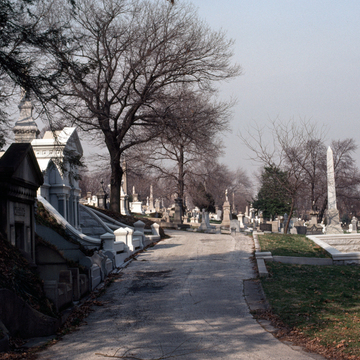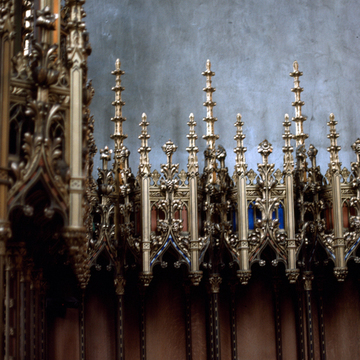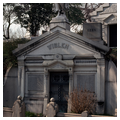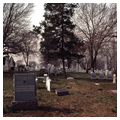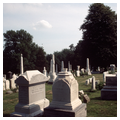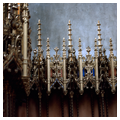This cemetery takes its name from another of the river estates (Laurel Hill, c. 1765) that was purchased by a group of investors led by horticulturalist John Jay Smith. It was planned along the Schuylkill as a rural retreat and was the first such garden cemetery in Philadelphia and the second, after Mount Auburn near Boston, in the nation. At the end of the eighteenth century, concerns about disease and the rising size of cities spreading past their extramural cemeteries led to a movement to create garden cemeteries that could double as pleasure grounds.
In a design competition, Notman defeated the young and old lions of the profession, including William Strickland and Thomas Ustick Walter, by blending his skill at landscape arrangement with the architectural feature of a gatehouse with offices. At first glance his gatehouse seems pedestrian—a classical screen of columns against a blank wall, but the effect brilliantly contrasts the withheld view by opening to a path leading to a Gothic-styled baldachin in which was placed Scots-born sculptor James Thom's masterpiece Old Mortality. That work used Sir Walter Scott's tale of filial piety of an old craftsman reengraving the names of the Scots martyrs on their tombstones as a metaphor for the
The cemetery is also of interest because of the people who are buried here and for monuments by a host of important architects that together create a miniature architectural history of the city. William Strickland adapted the Roman tomb of Scipio for the monument (c. 1843) for Captain Isaac Hull, commander of the USS Constitution, adding the patriotic feature of an eagle grasping the stars and stripes in its talons. John Notman contributed a Gothic monument to Sara Harrison, and Alexander Milne Calder, sculptor of the impressive Penn statue atop City Hall ( PH49), carved the astonishing William Warner monument (c. 1879) with a soul escaping the sarcophagus. The Beaux-Arts integration of sculpture and architecture is represented by Zantzinger and Borie's handsome upright stone slab fronted by Alexander Stirling Calder's seated bronze figure of Clio for historian Henry Charles Lea, completed in 1911. In front is the flat granite slab of Captain Frank Furness (1839–1912).



